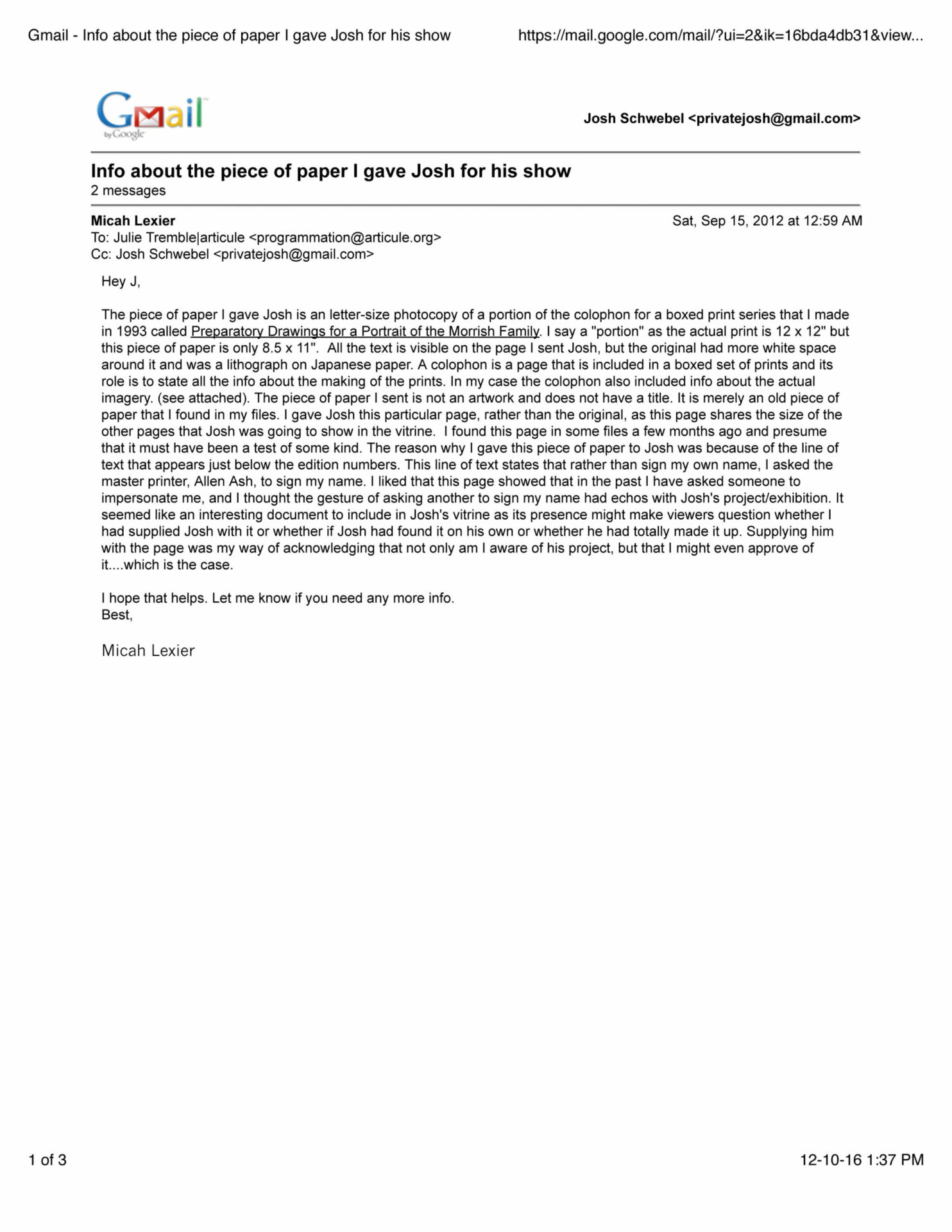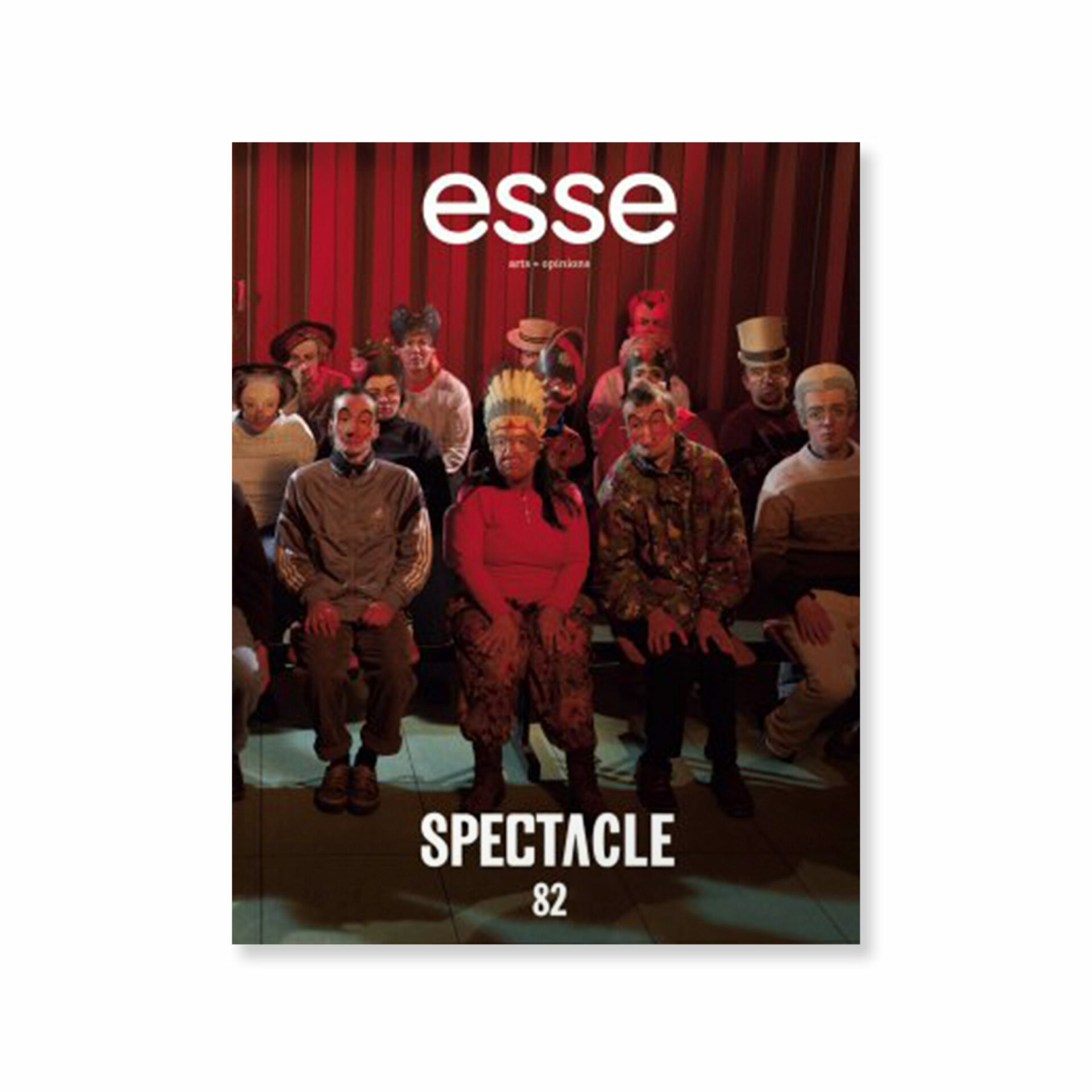
In 2012, articule, a long-standing artist-run centre in Montréal, received a dossier responding to its annual programming call from Toronto-based artist Micah Lexier. Lexier’s proposed artwork — a newspaper offered free to gallery visitors — was accepted by articule and slated to be exhibited alongside the work of Samantha Kinsley. Both Kinsley and Lexier proposed work made with paper, and beyond this material link their work had a thematic similarity. While the committee agreed that Lexier’s proposal seemed somehow incomplete, they conceded that based on the artist’s previous work, and the fact that it would be presented alongside Kinsley’s large-scale sculpture, the risk of programming it was minimal. After all, Micah Lexier is an important and well-respected Canadian artist.
Shortly following the decision by the programming committee to accept Lexier’s dossier, Julie Tremble, articule’s programming coordinator, received a letter from Joshua Schwebel, an emerging Montréal-based artist, stating that they had, in fact, been fooled, and that Lexier himself had never applied to the centre. Schwebel had proposed a fake project to articule under Lexier’s name as a means to investigate whether “reputation would outweigh a really weak proposal.”1 1 - “Josh Schwebel’s Anti-Social Practice,” Blouin Art Info, accessed March 11, 2014, http://ca.blouinartinfo.com/news/story/988517/interview-josh-schwebels-anti-social-practice. The show went on at articule, but instead of the proposed project by “Lexier,” Schwebel presented a work about reputation and quality within artist-run centres, in conversation with Lexier himself.
Titled Please Do Not Submit Original Works — a tongue-in-cheek reference to submission guidelines urging artists to send in slides with their applications as opposed to actual artworks — Schwebel’s piece was both a performance and an installation in the gallery. Schwebel’s use of Lexier’s name, CV, and portfolio was done without Lexier’s knowledge or permission. This was an act of impersonation. What Schwebel presented cannot accurately be described as a forgery. To forge is to make, adapt, or imitate something (generally an object such as art or currency) with the express intention of deceiving the reader. While his application to the gallery did include faked documents and was sent from a fake email address, Schwebel’s project wasn’t to imitate Lexier, but rather to underscore how the administrative structures of artist-run centres inform aesthetics. While he was attempting to briefly deceive the centre, the ultimate purpose of the short-term deception was to highlight where articule’s own mandate was, as Schwebel viewed it, deceptive in its language.
In her 2005 article “From the Critique of Institutions to an Institution of Critique”2 2 - Andrea Fraser, “From the Critique of Institutions to an Institution of Critique,” Artforum 44, No. 1 (Sept. 2005). Andrea Fraser presents a case for how institutional critique has shifted from an attempt to disrupt, disturb, or dismantle the institutions of art towards a practice of defence of these same institutions. Pushing against this type of soft critique, Fraser asks, “How can artists who have become art-historical institutions themselves claim to critique the institution of art?”3 3 - Ibid. This question is especially relevant to Schwebel’s practice: he is not so much interested in the institutionalized artist as he is in the dangers of alternative spaces, especially older, more established (and well funded) ones like articule, growing to resemble the larger institutions they were set up to contest.
Schwebel’s piece came out of the idea to make “use” of a famous artist as a means of exposing what he considered to be a growing trend in artist-run centres: the contradiction between a mandate to exhibit emerging artists and present radicalized practices and the temptation to bring in big-name artists. For Schwebel, artist-run centres are becoming indistinguishable from larger institutions in terms of their programming. I agree that we have witnessed an institutionalization of public art spaces in Canada over the last thirty years, in part due to a direct desire of the membership of these artist-run centres to move in this direction, but I would further argue that this is equally a consequence of shifts to the language of public funding at national, provincial, and regional levels, brought on by shifts in the governing administrations towards a more austere climate for the arts. Ultimately, while Schwebel was invested in “how the artist’s name, to the extent that its value functions as a brand, potentially outweighs the work s/he produces,” the main goal was to re-open space for criticality within the programming of artist-run centres, especially those whose mandates already suggest an openness to that type of work.
Schwebel only proposed this work to articule. This was in part due to his previous relationship with the gallery. Schwebel had submitted dossiers in the past but had not been successful in his applications. The committee had generally admired his work and they collectively encouraged him to apply to the Special Projects programming committee. Programming under the banner of Special Projects offers space for short-term, non-exhibition-based projects inside or outside the gallery. Artists receive “promotional and logistic support, access to the centre’s equipment, administrative infrastructure, venue, and financial support.”4 4 - “Call for Projects,” articule, accessed March 11, 2014, http://www.articule.org/en/call-for-projects. However, these special projects are not the same as the regular exhibition programming in duration or, frankly, prestige. For Schwebel, who sees his interventions as having the same weight and requiring the same amount of time for the public to digest as other more obvious exhibitionary projects, the suggestion that his work be reshaped was unappealing.
Schwebel didn’t target articule because his work had previously been rejected. To view Please Do Not Submit Original Works that way would reduce it to a petty and reactionary artwork, which it is not. articule was specifically singled out by the artist because its mandate states that it is “an open-access artist-run centre dedicated to the presentation of a broad range of contemporary art practices,” that it strives for “artistic excellence, interdisciplinarity and social engagement,” and that it specifically supports emerging artists while continuing to offer support for established artists who “test the limits of aesthetic gesture, and who commit themselves to the ideals of experimentation and risk-taking.”5 5 - “Mandate,” articule, accessed March 11, 2014, http://www.articule.org/en/mandate. Most importantly, however, “articule supports discursive and alternative activities.”6 6 - Ibid. It is precisely because of the centre’s self-assertion of its support of radical and counter-institutional practices, of its potential to be critical within its own mandate, that Schwebel’s fake-out was possible. While articule states that it is open to a multitude of types of proposals, Schwebel’s artwork responded to a perception that the gallery privileges practices which exhibit visible labour as opposed to immaterial labour, and which take up physical space in the gallery.
In his first contact with articule, Schwebel told Tremble that the forged dossier, which “deliberately lacked content,” was not meant as “a reflection on the quality or importance of Lexier’s oeuvre, but rather on the quality of the proposal.”7 7 - Schwebel, “letter to Julie Tremble”. For Schwebel, what was important was working with a Canadian artist who had reached a certain level of commercial and critical success. Schwebel identified Lexier as someone who specifically distances himself from the practice of making, who doesn’t always involve his own hand in his work, and whose art speaks to a larger discussion on the appropriation of labour. For example, in Lexier’s recent show at the Power Plant, One, and Two, and More Than Two, Lexier collaborated with over two hundred Toronto-based artists. While he is billed as the curator, he is nonetheless celebrated as the artist.

Photo : courtesy of Micah Lexier
Lexier was not made aware of Schwebel’s deception until after it occurred. But once he was apprised of the exhibition, Lexier “donated” a “work” to Schwebel for presentation with the other installation ephemera. In a letter to Tremble, Lexier explains that he provided Schwebel with a “letter-size photocopy of a portion of the colophon for a boxed print series . . . called Preparatory Drawings for a Portrait of the Morrish Family.”8 8 - “Micah Lexier email to Julie Tremble,” Joshua Schwebel, accessed March 11, 2014, http://joshuaschwebel.com/artwork/3429638_Micah_s_contribution.html. What Lexier gifted to Schwebel contained all the information present in the actual artwork, but it is not the artwork. It can more accurately be described as a test or proof for the final print. On the photocopy of the print, there is a line of text not included in the final print, which states that, “rather than sign my own name, I asked the master printer, Allen Ash, to sign my name. I liked that this page showed that in the past I have asked someone to impersonate me, and I thought the gesture of asking another to sign my name had echoes with Josh’s project/exhibition.”9 9 - Micah Lexier, email to Julie Tremble. While Lexier gave Schwebel the printed image, what was shown in the gallery was only the letter to Tremble. To the viewer, it is unclear how Schwebel acquired this “old piece of paper.” Is it forged, stolen, gifted, invented? For Lexier, the inclusion of his “not-art” in Schwebel’s show at articule is ambiguous at best and this ambiguity was critical.
While the proposal itself can be read as the actual artwork, it also manifested as an installation in the gallery and as a performative lecture. The installation was placed in a side area of the main gallery — a relegation to a secondary space which could be understood as a subtle payback for the joke played on articule — but it is important to note that the project submitted by “Lexier” was accepted alongside Kinsley’s large-scale sculpture, and the newspaper project that was originally accepted would have taken up significantly less room than Schwebel’s actual installation. What Schwebel presented, both in the gallery and on his website, which acts as another important site for this artwork, were the exchanges between himself and Tremble as a representative for articule. For the performative lecture, Schwebel curated a panel of “experts” made up of two critics who read pre-written statements about his project: Carl Samuels, a visiting academic and critic from New York City and Patrice Loubier, a Montréal-based art critic. The discursive nature of Schwebel’s project for articule was further emphasized when it became apparent that both “critics” were reading from almost identical texts, putting into question its authorship, and that “Samuels” was in fact Carl Schwebel, the artist’s father. The repetition of the read texts created a sensation of doubt in the audience, but ultimately it only left a lingering feeling of uncanny déjà vu. Because articule, much to Schwebel’s surprise, was excited to participate, he had to dramatize the critique through a performance.
When Tremble received Schwebel’s letter, she approached the board of directors to make a decision on how to proceed with the dossier. Unanimously, articule’s board voted to move ahead with the project and was excited to present a self-critical work. At no point was cancellation an option. Schwebel was absolutely correct in assuming that articule, as their mandate suggests, would be open to self-reflexivity, and it should be noted that Please Do Not Submit Original Works has had a lasting effect on the centre and its programming.
What was revealed to everyone through Schwebel’s artwork was the absolute need to continue making space in artist-run centres for work that pushes against the grain and which maintains the original intention of the artist-run centres to experiment and offer alternatives to the type of projects most often promoted by other, larger art institutions — effectively, to continue the task of self-critique set out when artist-run centres were initially developed.
